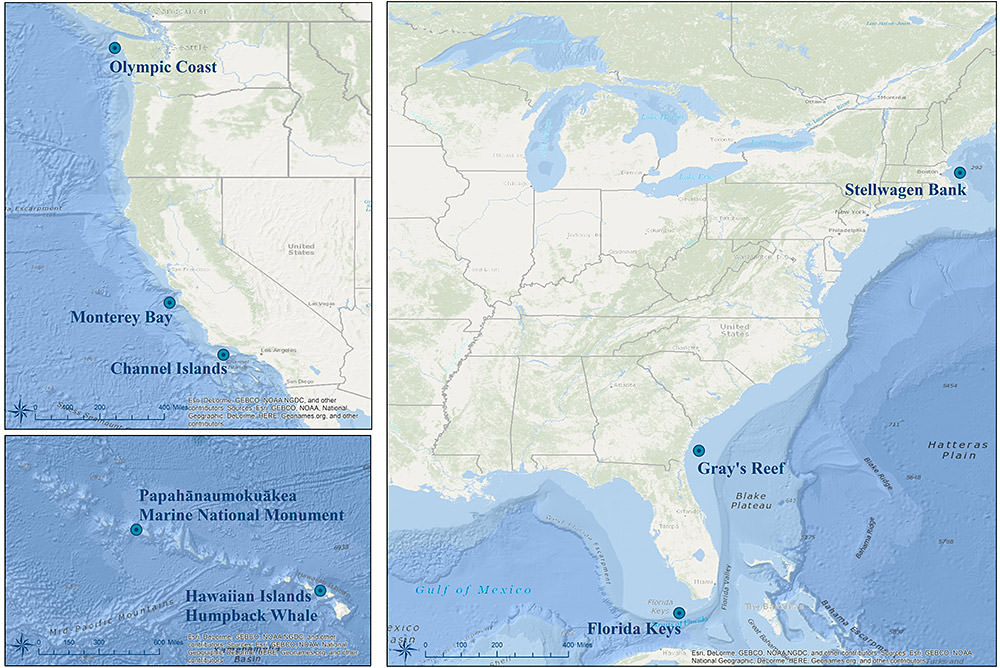Explosion Detection Events Recorded at SanctSound Site CI01_07
This record represents the explosions detected from raw passive acoustic data. All
acoustic data were processed using Triton's Explosion Detector, which is based on
a cross-correlation of the recording with a template explosion. The detector divides
the recording into sequentially analyzed sections of 75 s. The detector outputs are
a series of .mat files that can be evaluated using GPLReview. The original wav file
was decimated to a sample rate of 12 kHz, a requirement of the algorithm. The default
parameters work well for most explosive sounds. These data were recorded at SanctSound
Site CI01_07 between March 05, 2021 and July 01, 2021.
- Cite as: NOAA Office of National Marine Sanctuaries and U.S Navy. 2021. Explosion Detection Events Recorded at SanctSound Site CI01_07, SanctSound Data Products. NOAA National Centers for Environmental Information. https://doi.org/10.25921/jypn-1s94. [access date].
- 10.25921/jypn-1s94
- NCEI Metadata ID: gov.noaa.ncei.pad:NOAA-Navy-SanctSound_CI01_07_Explosions
gov.noaa.ncei.pad:NOAA-Navy-SanctSound_CI01_07_Explosions
| Search Data |
|
| Download Data |
|
| Distribution Formats |
|
| Ordering Instructions | Contact NCEI for other distribution options and instructions. |
| Distributor | NOAA National Centers for Environmental Information ncei.info@noaa.gov |
| Dataset Point of Contact | NOAA National Centers for Environmental Information ncei.info@noaa.gov |
| Dataset Point of Contact | Carrie Wall NCEI Passive Acoustic Archive Lead NOAA National Centers for Environmental Information pad.info@noaa.gov |
| Coverage Description | Site CI01_07 |
| Time Period | 2021-03-05T23:00:00Z to 2021-07-01T15:00:00Z |
| Spatial Bounding Box Coordinates |
West:-120.06702
East:-120.06702
South:34.04358
North:34.04358
|
| Spatial Coverage Map | |
| General Documentation | |
| Associated Resources |
|
| Publication Dates |
|
| Edition | Final SanctSound Data Product |
| Dataset Progress Status | Complete - production of the data has been completed |
| Data Update Frequency | As needed |
| Purpose | These data are available to the public for a wide variety of uses including scientific research and analysis. |
| Dataset Citation |
|
| Cited Authors |
|
| Principal Investigators |
|
| Collaborators |
|
| Publishers |
|
| Acknowledgments |
|
| Theme keywords | Global Change Master Directory (GCMD) Science Keywords
|
| Data Center keywords | Global Change Master Directory (GCMD) Data Center Keywords
|
| Platform keywords | Global Change Master Directory (GCMD) Platform Keywords
|
| Instrument keywords | Global Change Master Directory (GCMD) Instrument Keywords
|
| Place keywords | Global Change Master Directory (GCMD) Location Keywords
|
| Project keywords | Global Change Master Directory (GCMD) Project Keywords
|
| Use Constraints |
|
| Access Constraints |
|
| Other Constraints | Cite as: NOAA Office of National Marine Sanctuaries and U.S Navy. 2021. Explosion Detection Events Recorded at SanctSound Site CI01_07, SanctSound Data Products. NOAA National Centers for Environmental Information. https://doi.org/10.25921/jypn-1s94. [access date]. |
| Fees |
|
| Processing Steps |
|
| Instrument |
|
| Platform |
|
Last Modified: 2023-06-15
For questions about the information on this page, please email:ncei.info@noaa.gov
